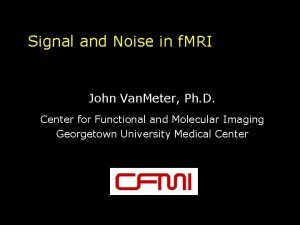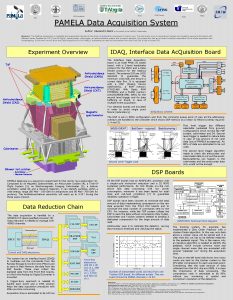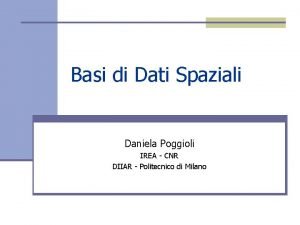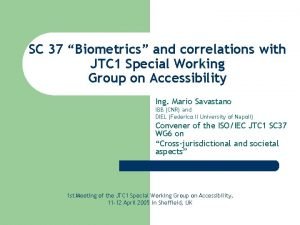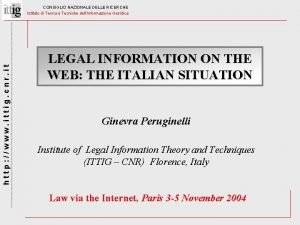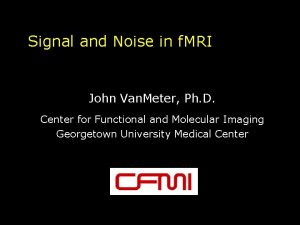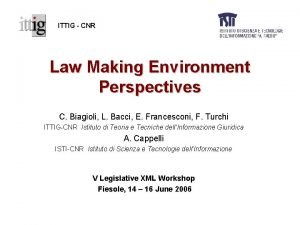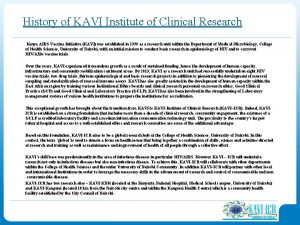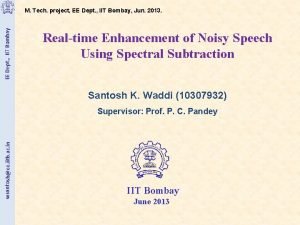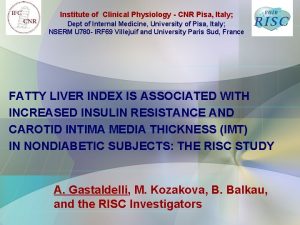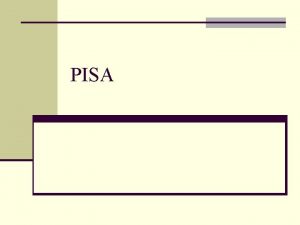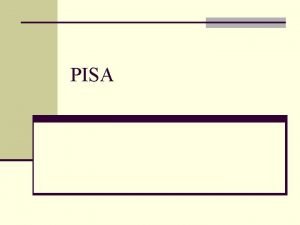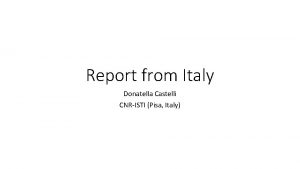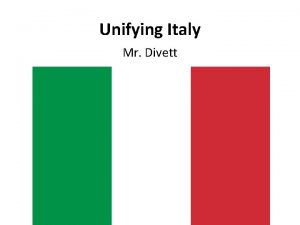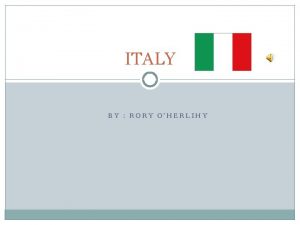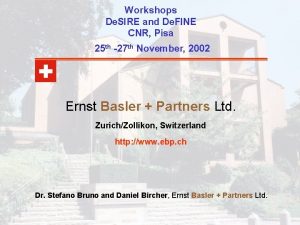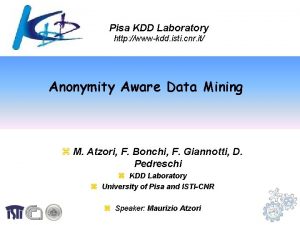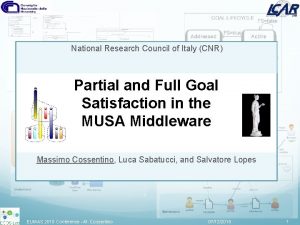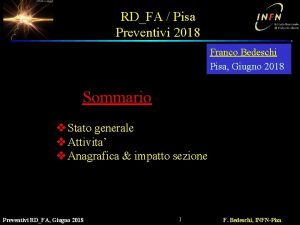Institute of Clinical Physiology CNR Pisa Italy Dept






















- Slides: 22

Institute of Clinical Physiology - CNR Pisa, Italy; Dept of Internal Medicine, University of Pisa, Italy; NSERM U 780 - IRF 69 Villejuif and University Paris Sud, France FATTY LIVER INDEX IS ASSOCIATED WITH INCREASED INSULIN RESISTANCE AND CAROTID INTIMA MEDIA THICKNESS (IMT) IN NONDIABETIC SUBJECTS: THE RISC STUDY A. Gastaldelli, M. Kozakova, B. Balkau, and the RISC Investigators

Introduction • Patients with nonalcoholic fatty liver disease (NAFLD) have a high risk of developing cardiovascular diseases (CVD). • This high risk is probably due to associated risk factors, including obesity, insulin resistance and hyperglycemia/diabetes.

Aim of the study We wanted to evaluate the association between: 1. fatty liver and insulin resistance (IR) 2. fatty liver and carotid atherosclerosis (carotid intima media thickness, IMT) in a large population of normal subjects (RISC study) at low risk for CVD.

EGIR-RISC (Relationship between Insulin Sensitivity and Cardiovascular disease) The RISC project is carried out in 19 recruiting centres in 14 European countries

EGIR-RISC European Project: • The principal aim of the study is to examine whether insulin sensitivity (directly measured with the euglycaemic clamp technique) predicts cardiovascular disease (CVD) independently of other factors. S Hills et all, Diabetologia 2004

EGIR-RISC European Project: Population (n=1290): – a healthy cohort – men and women aged 30 to 60 years – recruitment (2002 -2004), from 19 clinical centers in 13 countries In all subjects we evaluated: – – Body composition and physical activity Metabolic profile (ALT, AST, GGT, TG, Cholesterol) Glucose tolerance by OGTT Insulin sensitivity by a hyperinsulinaemic euglycaemic clamp – Carotid intima media thickness (IMT) S Hills et al Diabetologia 2004

Fatty Liver Index • The limitations of a liver biopsy (the gold standard for the evaluation of NASH) have led to considerable interest and attempts to diagnose this condition with laboratory tests and imaging modalities. • The fatty liver index was recently developed and validated in a large group of subjects of the Dionysos Study with (n=280) and without (n=216) fatty liver. • The index uses an algorithm based on BMI, waist circumference, triglycerides and GGT with an accuracy of 0. 84 (95%CI 0. 81– 0. 87) in detecting fatty liver. FLI>60 probability to have FL > 78%, FLI<20 probability not to have FL > 91%. Bedogni G et al, BMC Gastroenterol, 2006

RISC study and Fatty liver • subjects were categorize using the fatty liver index, in 3 groups: 1. FLI<20 no FL (probability not to have FL > 91%) 2. FLI: 20 -60 intermediate group 3. FLI>60 FL (probability to have FL > 78%)

Clinical characteristics of RISC subjects R 2 P-value* 0. 17 <0. 0001 0. 06 <0. 0001 31. 3± 0. 3 0. 68 <0. 0001# 92. 3± 0. 3 104. 2± 0. 6 0. 75 <0. 0001# 0. 30± 0. 01 0. 42± 0. 01 0. 54± 0. 01 0. 28 (ln) <0. 0001 AST 0. 32± 0. 01 0. 36± 0. 01 0. 40± 0. 01 0. 11 (ln) <0. 0001 GGT# 0. 26± 0. 01 0. 43± 0. 01 0. 64± 0. 03 0. 34 (ln) <0. 0001# TG# 0. 79± 0. 01 1. 19± 0. 02 1. 86± 0. 09 0. 42 (ln) <0. 0001# FLI<20 FLI<60 FLI>60 N=652 N=434 N=204 FLI 8. 6± 0. 2 37. 0± 0. 6 76. 6± 0. 7 F/M 486/166 164/270 63/141 or 3/1 or 0. 6/1 or 0. 45/1 607/35 389/45 155/46 or 35/1 or 9/1 or 3/1 BMI# 22. 8± 0. 1 26. 8± 0. 1 WAIST# 77. 1± 0. 1 ALT NGT/IGT *multiple regression after correcting for age gender and center #values included in the index

Fatty liver index was independent on alcohol intake in RISC 100 FLI- index 80 60 Females Males 40 20 0 0 50 100 150 200 250 300 350 400 450 Grams of alcohol Female: R 2=0. 000, p=ns Male: R 2=0. 006, p=ns

6 Fasting glucose * * 5 4 3 2 1 0 FLI<20 FLI<60 FLI>60 Insulin concentration (pmol/l) Glucose concentration (mmol/l) Metabolic characteristics of the subjects 60 Fasting Insulin * * 50 40 30 20 10 0 FLI<20 *p<0. 0001, after correcting for age, gender and center FLI<60 FLI>60

HDL cholesterol * * Total/HDL cholesterol (mmol/l) Fatty liver index and lipids 1. 6 1. 2 0. 8 14 12 10 8 6 4 2 0 0. 4 0 FLI<20 FLI<60 LDL cholesterol * 3 F M 0 FLI<20 FLI<60 FLI>60 ln(FFA) umol/l LDL cholesterol (mmol/l) * 1 0 20 40 60 80 100 120 FLI- index R=0. 51, p<0. 0001, after correction for center, age and gender FLI>60 2 -20 4 FFA suppression during clamp * * 3 2 1 0 FLI<20 FLI<60 FLI>60

Fatty Liver index and physical activity Atigraph counts * * 400000 300000 Females Males 200000 100000 0 FLI<20 FLI<60 FLI>60 Partial R=-0. 20, p<0. 0001, after correction for center, age and gender No significant correlation was found if FLI was substituted with ALT

Fatty liver, LFT and insulin resistance • Both fatty liver and altered liver function tests (LFT) are associated with the presence of insulin resistance. (Bugianesi et al, Hepatology 2005; Yki-Jarvinen, Ann Med 2005; Gastaldelli A et al, Gastroenterology 2007)

Fatty liver index and insulin resistance 40 30 20 10 FLI<20 FLI<60 * FLI>60 * (mmol/min Kgffm x pmol/l) Fasting EGPx. Insulin 50 12 Adiponectin 800 60 0 Hepatic Insulin resistance * * 70 (mmol/min Kgffm) Glucose disposal Peripheral insulin sensitivity * * 600 400 200 0 FLI<20 FLI<60 FLI>60 No association with EGP during clamp 10 *p<0. 001 after correcting for age, center, gender, alcohol intake and physical activity 8 6 4 2 0 FLI<20 FLI<60 FLI>60

Fatty liver and cardiovascular risk Previous studies have shown that NAFLD and NASH are associated with carotid atherosclerosis (Volzke H et al World J Gastroenterol 2005; Targher G et al, Diabetes Care 2006; Lonardo A et al World J Gastroenterol 2007) However, most of the studied subjects carried independent risk of CVD such as diabetes, hypertension or hyperlipidemia. The RISC study comprised only subjects at low CVD risk, i. e. , without diabetes, hypertension or hyperlipidemia

Fatty Liver Index and blood pressure Diastolic BP (mm. Hg) Systolic BP (mm. Hg) 150 140 130 120 110 100 90 80 70 60 50 0 20 40 60 80 100 FLI- index R=0. 40, p<0. 0001 after correction for center, age, gender Female Male 0 20 40 60 80 100 FLI- index R=0. 36, p<0. 0001 after correction for center, age, gender

Fatty Liver Index and cardiovascular risk 1. 1 * 0. 7 . 9. 8 F M . 7. 6. 5. 4. 3 0 20 40 60 80 FLI- index 100 Common carotid artery comm carot art 1 * 0. 6 0. 5 0. 4 0. 3 0. 2 0. 1 0 FLI<20 FLI<60 FLI>60 R=0. 54, p<0. 0001, after correction for center, age, gender, systolic BP, physiical activity, LDL, alcohol intake No significant correlation was found if FLI was substituted with ALT, or when to common carotid artery we substituted bulb, all segments or ica.

Correlates of Fatty Liver Index In multivariate analysis of the whole dataset (adjusting for age, gender, center, and alcohol consumption), high FLI was associated with: • IR (r=0. 45), LDL (r=0. 26), ALT (r=0. 35), AST (r=0. 12), mean blood pressure (BP, r=0. 25), IMT (r=0. 18), • HDL (r=-0. 41), adiponectin (r=-0. 31), physical activity (r=-0. 19) (all p<0. 0001)

Summary In a young to middle-age population at low cardiovascular risk, values of FLI>60 (i. e. , with probability to have FL > 78%) are associated with • elevated concentrations of plasma glucose, insulin, lipids, liver enzymes, • insulin resistance (peripheral and hepatic) • increased IMT.

Conclusion Subjects with values of FLI>60 have not only a high probability to have fatty liver (> 78%) but they carry an increased risk for insulin resistance, CVD and atherosclerosis.

Acknowledgments RISC principal investigator: prof. E. Ferrannini, Pisa, Italy RISC coordinating office: S. Hills and L. Mocha, Pisa, Italy RISC Centers Pisa, Italy London, UK Villejuif, France Amsterdam, The Netherlands Newcastle, UK Padova, Italy Odense, Denmark Dublin, Ireland Perugia, Italy Geneva, Switzerland Frankfurt, Germany Malmo, Sweden Rome, Italy Glasgow, UK Vienna, Austria Madrid, Spain Athens, Greece Milan, Italy Belgrade, Serbia Kuopio, Finland Lyon, France A special thanks to: G. Bedogni and FLIN (Fatty Liver Italian Network) Supported by: : EU contract QLG 1 -CT-2001 -01252, Astra Zeneca Sweden
 Cnr mri
Cnr mri Cnr iom
Cnr iom Cnr
Cnr Libro matricola cnr
Libro matricola cnr Ibb cnr
Ibb cnr Ittig cnr
Ittig cnr Cnr mri
Cnr mri Addreesee
Addreesee Gestform
Gestform Kavi kenya
Kavi kenya Organizational structure of finance department
Organizational structure of finance department Dept of education
Dept of education Gome dept
Gome dept Dept. name of organization (of affiliation)
Dept. name of organization (of affiliation) Affiliate disclodures
Affiliate disclodures Dept of education
Dept of education Dept a
Dept a Gome dept
Gome dept Iit
Iit Worcester electrical inspector
Worcester electrical inspector Bromocicloesano
Bromocicloesano Hoe dept
Hoe dept Employment first ohio
Employment first ohio
